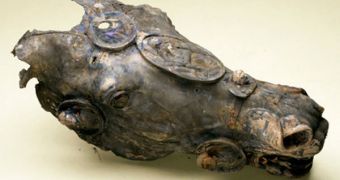Historians knew that the Romans maintained a strong presence in what is now Germany during the peak of their empire, but a new find seems to prove that their level of establishment in the region was a lot higher than first though. At the bottom of a well in the renowned archaeological site Waldgirmes – an ancient Roman town –, diggers discovered a statue fragment depicting a full-size horse head, adorned with gold leaves. Such a luxurious object could have only belonged to a man of great importance for the Empire, historians believe.
Their hypothesis was immediately confirmed, when further investigations uncovered another part of the statue, featuring the foot of a Roman senator, judging by its sandals. Experts say that the horse head, which is cast in heavy bronze and weighs about 25 kilograms, was most likely a part of a mount for this famous man, as it is known that most Roman statues depicting leaders were immortalized on top of their respective horses. The newly found artifact is the most well-preserved such bronze statue dating back from Roman times in the world, ScienceNow reports.
In the rich trappings that adorn the 50-centimeter-long horse head, archaeologists have discovered a carving of Mars, the Roman god of war. This find hints at the fact that the person that the entire statue depicted was either an important general, or a former military man turned politician. According to the Director of the German Archaeological Institute's Roman-Germanic Commission, Friedrich Luth, the head was found at the bottom of an 11-meter-deep, wood-reinforced well shaft, on August 12th. The sculpture was dated back to the time of Augustus' rule, around 9 BCE.
The analysis of the new fragments, as well as that of countless others found in Waldgirmes seem to suggest that the Romans had big plans for the city, maybe to even make it the capital of the territory that was then called Germania Magna (The Great Germany). Several other pieces of statues that were found in the area were buried around a 2,200-square-meter forum in the center of the town. The craftsmanship on the artifacts suggests they were made in Italy and then shipped to the German territories, over the Alps.
Archaeologists find it peculiar that the Romans invested so much in this area, which is located in a region previously thought to be out of their reach. Located some 40 kilometers North of Frankfurt, Waldgirmes is way beyond the Empire's usual routes. The city's life was, however, short. In 9 CE, three Roman legions, led by general Quintilius Varus, perished in the Battle of the Teutoburg Forest, at the hand of Germanic tribesmen. The city was most likely abandoned at that time as well. “It makes sense that the troops left in quite a hurry, or we must imagine they would have taken [the statue of] their emperor with them,” Luth concludes.

 14 DAY TRIAL //
14 DAY TRIAL //